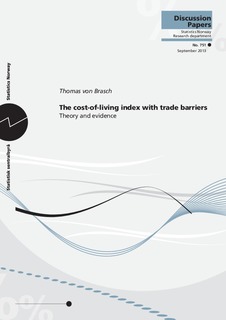| dc.contributor.author | von Brasch, Thomas | |
| dc.coverage.spatial | Norway | nb_NO |
| dc.date.accessioned | 2019-11-12T12:14:54Z | |
| dc.date.available | 2019-11-12T12:14:54Z | |
| dc.date.issued | 2013-09 | |
| dc.identifier.issn | 0809-733X | |
| dc.identifier.uri | http://hdl.handle.net/11250/2627928 | |
| dc.description.abstract | The standard cost-of-living index hinges on the assumption that there is free trade. Applying it to situations where trade barriers are present yields biased results with respect to a true cost-of-living index. Import price indices are particularly vulnerable to this bias since many of the goods included in these indices are characterised by either explicit or implicit trade barriers. In this article I generalise the cost-of-living index to also allow for barriers to trade in the form of quantity constraints. Further, I develop an upper bound index to the true cost-of-living index when trade barriers are present. The upper bound index has an intuitive interpretation and it is easy to calculate. In the case of clothing imports to Norway the mean annual upper bound cost-of-living bias due to trade barriers is between 0.9 - 1.5 percentage points. It is also shown that average prices, which is often used in the literature, is not a measure of cost-of-living and the annual underestimation of how trade liberalisation has impacted inflation from using average prices was at least 0.8 percentage points. | nb_NO |
| dc.language.iso | eng | nb_NO |
| dc.publisher | Statistisk sentralbyrå | nb_NO |
| dc.relation.ispartofseries | Discussion papers;751 | |
| dc.subject | JEL classification: C43 | nb_NO |
| dc.subject | JEL classification: E31 | nb_NO |
| dc.subject | JEL classification: F14 | nb_NO |
| dc.title | The cost-of-living index with trade barriers. Theory and evidence | nb_NO |
| dc.type | Working paper | nb_NO |
| dc.description.version | publishedVersion | nb_NO |
| dc.subject.nsi | VDP::Matematikk og Naturvitenskap: 400::Matematikk: 410::Statistikk: 412 | nb_NO |
| dc.source.pagenumber | 24 | nb_NO |
